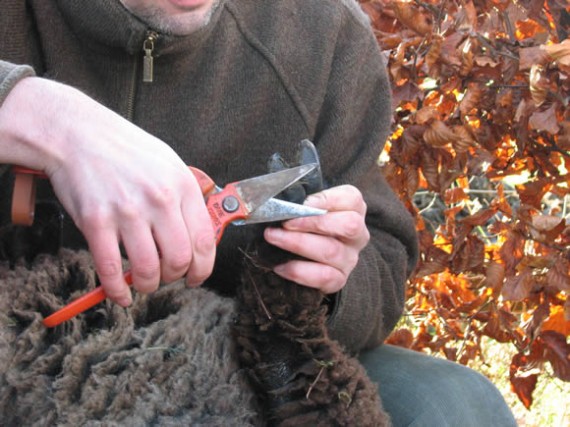Feet and foot trimming
A sheep that is lame will not thrive as well as one that is sound so foot health in sheep is an important welfare issue. Sheep that are kept on wet ground or that are housed are more likely to experience foot problems than those kept on rough, stony ground but most sheep will need their feet trimmed at some time during their life.
If you are new to sheep, try to get an experienced shepherd to give you some training – watch him / her demonstrate, then try it yourself under supervision until you are confident. It’s always better to take off too little than too much – but always have an antibiotic spray with you just in case you cut too deep.
 We learned to trim sheep's feet from the breeder we bought our first stock from
We learned to trim sheep's feet from the breeder we bought our first stock from
The general advice now is to only trim sheep that display signs of lameness. I do like to routinely check and trim mine before tupping and after lambing. And don’t forget your tup’s feet – a lame tup won’t be keen to work and remember he’s going to have to take his weight on his back feet, so make sure they are in good condition.
Footrot
Footrot is a bacterial infection of the horny parts and the adjacent soft structures of the feet. It is most often a problem on wet, marshy or badly drained pasture although the wet itself doesn’t cause the disease, it simply facilitates infection. Affected sheep will usually be quite lame; on examination of the foot, there may be a swelling over the coronet or an area of the horn will be soft, painful on pressure, “rotten looking” with a foul-smelling discharge present.
Footrot can be eradicated by keeping pasture free of sheep for three weeks and by isolating and treating affected sheep. A vaccine containing inactive strains of one of the causal bacteria is available.
Ideally, sheep with footrot should be housed in a dry, strawed yard and given daily treatment. The feet should be trimmed until all of the “rotten” material has been removed then the feet should be dipped in zinc sulphate solution.
Oxytetracycline spray is useful and in bad cases, a long acting antibiotic can be very effective. If you are treating sheep with footrot, take care not to spread the infection – keep hands, knife or foot shears clean and dispose of foot trimmings carefully.
Scald
Scald is a bacterial infection that arises between the two digits of the feet causing lameness. It is often associated with frost or wet spells, and usually with lambs. It can be treated by trimming and cleaning the foot, then applying an antibiotic spray or dipping the foot in iodine solution.
- Previous « Sheep Health & Welfare
- Next Shearing Sheep »

About Rosemary Champion
Rosemary lives on a 12 acre smallholding in Angus, in the east of Scotland, where she keeps Ryeland Sheep, Shetland cattle and assorted poultry. She was destined to be a smallholder from an early age.
Further Reading
 Sheep Medicine Phillip R. Scott |  Sheep Health, Husbandry and Disease: A Photographic Guide Agnes C. Winter |  The Veterinary Book for Sheep Farmers David Henderson |  The Sheep Keeper's Veterinary Handbook Agnes Winter & Judith Charnley |  Beautiful Sheep: Portraits of Champion Breeds Kathryn Dun |
Smallholding shop
When you click links below and make a purchase, this may result in this site earning a commission from eBay.

Obstetric lube Gel 500ml
Ritchey Superlube Thick Gel. A… from £2.64 + p&p

Super Sprayline Marker Aerosol - White 400ml
Super Sprayline Marker… from £5.78 + p&p

Lamb Sling each
Lamb Sling. Harness sling for… from £8.96 + p&p

First 24 POWDER colostrum 250g 10 Dose
Premium powder lamb… from £11.98 + p&p
















